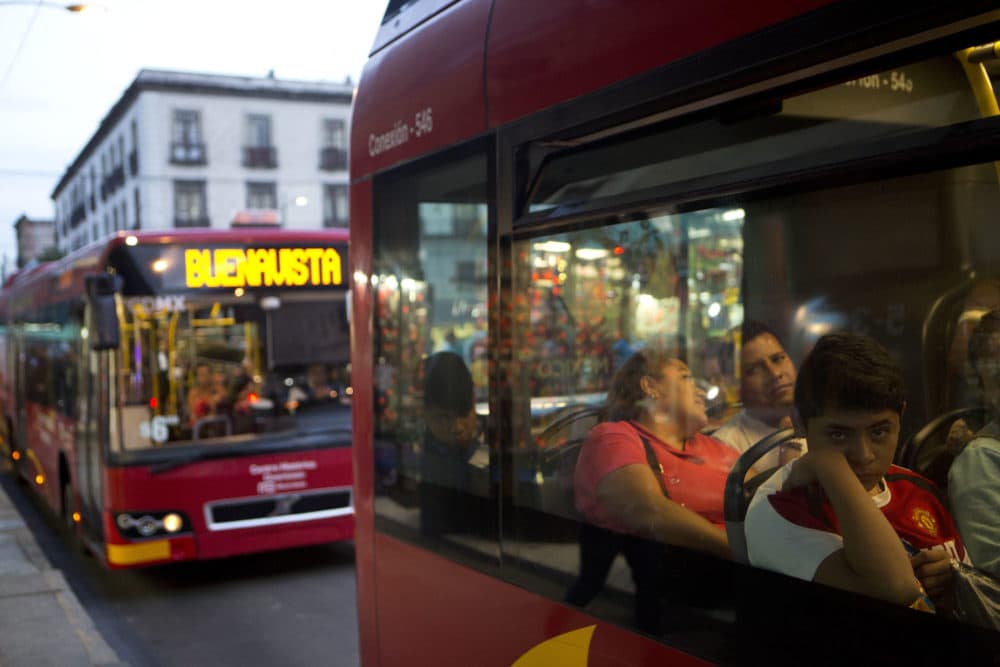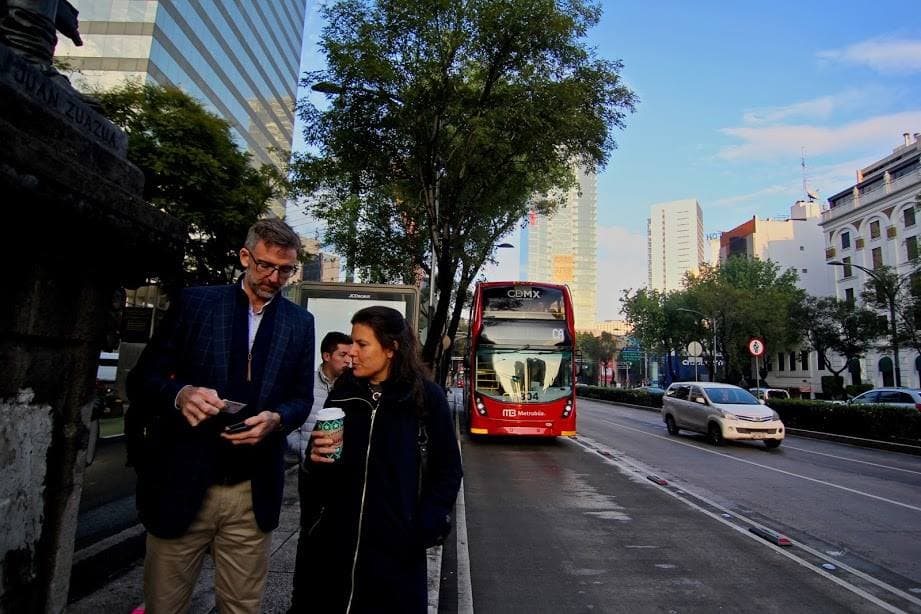Advertisement
Commentary
Finding One Solution To Boston's Traffic Woes — In Mexico City

Have you ever been riding a public bus and thought to yourself, “Gee, this feels just like being on really nice train!” Me neither. Until I experienced Metrobús, Mexico City’s bus rapid transit (BRT) system last fall.
Metrobús launched its first line in 2005 and has since grown to seven bus lines that crisscross the city, down wide boulevards and old narrow streets. Last November, I traveled to Mexico City with a delegation of Boston executives from the Alliance for Business Leadership to see Metrobús first hand, and to learn from the people who helped build it.
BRT, defined as a high-quality, bus-based transit system — with its own dedicated lanes, off-board fare collections and frequent service — has increasingly been a topic of conversation in Boston among groups including Transportation for Massachusetts and the Liveable Streets Alliance. In a city where complaining about traffic is a favorite pastime (Boston has been ranked one of the most congested urban areas in the U.S.), the promise of BRT holds special appeal: A 2015 report estimated that a bus trip from Dudley Square to downtown Boston, which currently takes 22.8 minutes, would take 12.5 minutes with gold-standard BRT. Other corridors would see similar benefits, perhaps yielding riders a 45 percent savings in commute time.

For a group of business leaders eager for more reliable forms of transportation for their employees and customers, BRT seemed worth exploring. And so, we headed south. Here’s what I observed in Mexico City:
Buses have their own lanes. Metrobús vehicles operate in lanes designated only for buses and emergency vehicles. The dedicated lanes don’t just last for a block or two, they go on for several kilometers — allowing buses to zip along otherwise crowded corridors. One evening, at the height of rush hour, we rode to our destination in a brand new double-decker bus, zooming past cars creeping block after block. At a meeting with CoRe Foro Urbano, a business group, a CEO told us that he regularly takes Metrobús to and from his office because it cuts his commute in half.
Bus lanes are often in the center of the roads. Metrobús often operated in the center lanes of the roadways, and cars were prohibited from making left turns to cross over the bus lane. It kept the buses moving quickly and made things safer for everyone.
You pay before you get on the bus. This isn’t true on every line of the Metrobús, but for several lines, you essentially pay to enter the bus stop. As a result, when the bus pulled up, all of the doors opened and people were able to get on and off quickly. Boarding and disembarking was seamless and speedy. (And wait times rarely exceeded two minutes.)
The bus station is level with the bus. Boarding platforms are slightly raised, so that when the bus pulls up, there’s almost no incline for passengers to scale. This is extremely important for issues of access for the disabled, elderly, or those with strollers or small children. It’s also more comfortable and less stressful, as more than one of the able-bodied business leaders in our delegation noted.

The elements of BRT combined to create the experience of being on a modern intra-city train. The ride was smooth and speedy, the buses were new and clean and boarding was straightforward. And there was no stigma. While the bus is seen in many cities (including Boston) as a lesser form of transit, in Mexico City the Metrobús is the cool-kid of public transportation. It doesn’t hurt that Metrobús riders have seen their commute times slashed by 42%.
With the many positives of BRT in Mexico City, there have been a few downsides. Parking spaces have been lost to accommodate bus lanes; some trees had to be cut down, too. Several areas now served by the Metrobús are struggling with gentrification. We heard more than once about the rising real estate values that have followed virtually every new line of Metrobús — a boon for property owners, but bad news for local residents who have been renting for years. Even so, the leaders we met with were positive about BRT, and are planning for expansion.
Advertisement
Other cities, including Rio de Janeiro, Bogota, Lima, Guatemala City, Istanbul, Seattle, Johannesburg, Beijing, Ottawa and Albuquerque have all adopted some form of BRT. These are communities Boston could and should learn from, about best practices and about pitfalls, particularly as applies to gentrification.
A 2015 report estimated that a bus trip from Dudley Square to downtown Boston, which currently takes 22.8 minutes, would take 12.5 minutes with gold-standard BRT.
As the adoption of BRT becomes more widespread, greater Boston is taking baby steps toward improving the bus experience by incorporating elements of BRT. Initial results from a pilot in Arlington showed that 94.7% of riders wanted the changes from the pilot to be made permanent. Last summer, Everett led the way in Massachusetts, becoming the first community to install level-boarding platforms for bus riders. This is in addition to the bus-only lane Everett piloted in 2016 to great success.
The pilot programs in Arlington and Everett are key to overcoming perhaps the biggest obstacle BRT has in Boston: being unknown. Hearing about BRT is one thing — experiencing it is another thing entirely.
Seeing what Mexico City accomplished with buses certainly has me thinking about BRT’s utility to Boston. Are buses that feel like trains the solution to all that ails us? Certainly not. But could they be a meaningful part of the solution? My experience in Mexico City tells me yes.
Follow Cognoscenti on Facebook and Twitter, and sign up for our twice-weekly newsletter.
